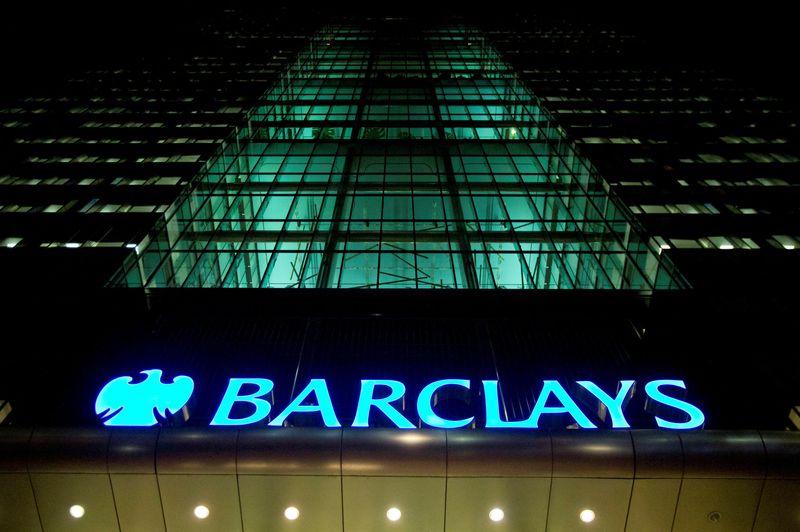
© Reuters. FILE PHOTO: The Barclays headquarters building is seen in the Canary Wharf business district of east London February 6, 2013. REUTERS/Neil Hall (BRITAIN – Tags: BUSINESS)/File Photo
By Sinead Cruise, Lawrence White and Stefania Spezzati
LONDON (Reuters) – Barclays (LON:) is betting it can revive its wilting share price by upping investment in a crop of its smaller businesses including U.S. credit cards, sources familiar with the matter said. But some of its top shareholders would prefer the quicker fix of a buyback.
Chief Executive C.S. Venkatakrishnan is studying plans to allocate more capital to the bank’s wealth management, U.S. credit card and global payments activities to boost returns, according to people familiar with his thinking and reported here for the first time, after drafting in Boston Consulting Group (BCG) to review strategy earlier this year.
A team of BCG consultants has taken up temporary residence at the bank’s headquarters in London’s Canary Wharf financial hub to help management brainstorm an optimal investment plan, one source familiar with the BCG review said.
The lender is pursuing an in-house review as well, the source added.
Another source inside Barclays’ investment bank, talking anonymously because they are not authorised to speak to the media, said lower staff attrition at its technology and back office operations had started to worry cost-conscious managers.
The BCG review could lead to layoffs, the source familiar with the review said, although no decisions have been made.
“As you would expect, we frequently work with various external consultants,” a Barclays spokesperson said.
A spokesperson for BCG declined to comment.
Some top Barclays investors, however, told Reuters they would have misgivings about a plan to prioritise investment over capital distributions.
They question the logic of pumping more capital into divisions that are small relative to their competitors as the global economy shivers and the lender’s shares suffer.
Instead, they want to see tighter cost control, twinned with bigger buybacks and dividends after the bank completed a modest 500 million pound ($646 million) buyback programme in April.
“We are keen to see the businesses we invest in acquire and grow if they can do so in a way that adds shareholder value,” said Richard Marwood, senior investment manager at Royal London Asset Management, one of Barclays’ 30 largest shareholders, according to Refinitiv.
“The hurdle they have to clear is: are the acquisitions better uses of capital than retiring equity? When your shares are lowly valued, that is a tougher benchmark to beat.”
‘NERVOUS’
For Venkat, as the veteran banker is commonly known, the stakes are high.
Two years into his tenure, Barclays’ stock price to tangible book value, a measure of market value against assets, is 0.54, the lowest among major British banks and well below rival HSBC’s 0.87, Refinitiv data shows.
Barclays emerged from the 2008 financial crisis with a once-in-a-generation opportunity to bulk up on Wall Street, after buying Lehman Brothers’ U.S. operations. But nailing the right business mix to woo new investors without repelling its more conservative backers has challenged executives ever since.
After defeating a push by activist investor Edward Bramson to shrink its investment bank in 2021, the 330-year old lender has stuck to its transatlantic universal banking model spanning investment banking, and consumer and corporate lending, gradually growing group profits.
But a recent shake-up at its investment bank has raised concern about Barclays’ ability to compete amid a worldwide dealmaking slump.
A U.S. securities trading blunder that triggered a $361 million regulatory penalty and blighted recent earnings remains a drag on shareholder confidence too.
That has made investors “nervous about investment over the simple maths of buying back shares at half book value,” said Richard Buxton, investment manager at Jupiter Asset Management, a top 25 Barclays shareholder, according to Refinitiv.
“I can understand why Barclays wants to invest more behind sub-scale businesses if they can evidence getting the returns from them,” he added.
Some smaller investors hope the BCG review might offer a fresh take on whether an investment banking spinoff could give shareholders the value they crave.
“You might get a better valuation if you demerge the investment bank … They are not valued properly together,” said Alan Beaney, chief executive at RC Brown Investment Management, which has held Barclays shares since 2012.
A Barclays spokesperson said the bank’s businesses continued to perform well and its business mix was “robust”.
OVERHAULS
Barclays has also engaged another global consultancy to analyse whether some of its payments businesses should be expanded or combined with other providers, Reuters reported in June.
Meanwhile, Barclays’ stock has fallen around 3.5% this year, underperforming a 10% gain in a benchmark index of European banks and internationally-focused European rivals like BNP Paribas (OTC:) and HSBC, which have risen by around 5.5% and 18% respectively.
Barclays underwent several major overhauls in the decade following the 2008 financial crisis, including a 2014 jobs cull and a 2016 exit from Africa.
But while such strategies have helped to keep Barclays in the black throughout the pandemic and the current bout of inflation-led economic malaise, management faces a battle to convince investors they can depend on those returns.
Barclays’ goal is to hit a return on tangible equity, a key measure of profitability, of more than 10%. While its British retail and business banking arm delivered 18% in 2022, the two other divisions which house payments and investment banking narrowly scraped the 10% goal.
“We estimate the bank ought to be able to generate around 19 billion pounds of profit over the course of 2023-2025, and we believe more of this should be returned to shareholders to better address the share price weakness as opposed to another strategy review,” Jefferies analysts said in a note.
($1 = 0.7736 pounds)





